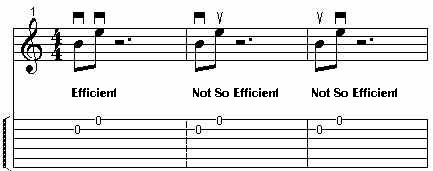Our Fragile Egos
Q: How many guitarists does it take to change a lightbulb?
A: 50 – 1 to change the bulb, and 49 to stand around and say, “I can do that”.
A subscriber to Woodsheddin’ recently wrote to me and expressed how he was so awed by some of the guitarists that he admired that it was depressing to him, causing him to despair of ever achieving great heights. It was easy for me to identify with this feeling, because I’ve felt that way myself – more frequently than I care to admit. I think we’ve all been there at one time or another.
I responded that there are few truths that help you understand and accept your place in the musical “pecking order”, such as it is, as follows:
- There are always quite a few people who are a lot better than you in some really impressive manner. There are a lot of other people out there. Even when just a small percentage are obviously gifted with immense talent, that adds up to quite a few people. In other words, you can be truly fantastic and still not be in the top 100 talented people or groups – even in a niche genre!
- Even if your talent and skills aren’t the scary, mind-boggling type (yet) – as in Jimi Hendrix, Celine Dion, Art Tatum, etc. – your creations can still have artistic value. What does that mean? To me it means that sometimes people really enjoy what I play or sing. Sometimes it just means that I enjoy what I make, although I have to say that appreciation in isolation can feel empty.
And you might be more unique than you think. Sometimes there are a few tricks you know that most people don’t. In any case, you can always “be you” better than anybody else can (yes, of course it’s a cliché, but that doesn’t make it wrong). Discovering just what this means might be a lifelong search. It might be more about personality, or songwriting, than about technical instrumental wizardry per se. And the world may or may not appear to be vitally interested in the theater of “you”, but you should be. - Commercial success in music isn’t strongly correlated with talent and skill. A considerable level of talent and skill are usually prerequisites for success, but once you’re past the basics, many other factors help determine the outcome: ambition, appearance, resources, contacts, background, age and being in the right place at the right time. For instance (warning: cynicism alert!), if you’re a gorgeous (male or female) singer with incredible pipes, living in LA and aged 17-25, your chances for superstardom might be decent. The rest of us would do well to be happy with other dreams.
- Just because you’re not famous, it doesn’t mean you’re not good. Popular music tastes are fashions. Your own tastes are your own tastes, regardless of fashion. Sometimes the two things coincide, you’re in the right place at the right time, and your skills are at the right level to benefit. Then, it’s BINGO. Many of us (such as myself) have tastes that are unlikely ever to coincide with the popular imagination. We just have to appreciate and live with that fact.
- Even if you’re not good – or you don’t think you’re good – you can still enjoy the learning process and playing with other people. The satisfaction that you derive from the process of getting together and making music with others can be immense at any level of accomplishment.
- When you start out, you can’t expect to be very good. As you play more, you get better. You almost can’t avoid it, as long as you keep playing.
- You set your own values. I don’t play to filled arenas, or even large concert halls. But I do play out. And for me, if at least some people can derive a unique kind of joy from my playing – and they do, at least on occasion – that is sufficient.




 etc.
etc.
 etc.
etc.